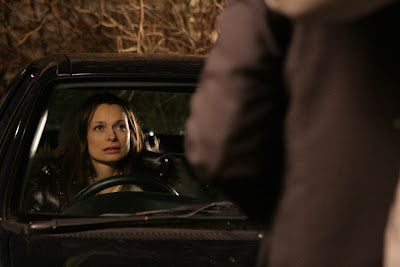 |
| Jason Robinson, sound recordist for DEVIATION |
We've mentioned before several times that Thrillers too often become dramas "with a bit of killing/fighting in". Another big issue affecting Thriller scripts in the spec pile is the fact they "run on the spot". In other words, the story does not feel as if it PROGRESSES: events may happen, but they do little to ADVANCE THE STORY.
Think again about that all-important *classic* Thriller movie poster, with the running protagonist. If Comedy is about the "funny" and Horror is about the "spills", then Thriller is very much about THE CHASE.
Question: if you are being CHASED and your life (literally or figuratively) is actively in danger, what is the best thing to do -- stop? No, of course not:
YOU JUST KEEP GOING.
But now let's consider actual running in real life. In sprints, the running itself must be fast - and is over relatively quickly, sometimes in just seconds. We cannot compare a movie to a sprint; it would be difficult to apply the notion even to a short film (outside of the "micro short" category).
Instead, a movie is more like a marathon. Runners must "limber up" and start off usually at a fairly steady pace. In The London Marathon (and other high profile running events), there will be a "pace setter" who will run the first five-to ten miles, before dropping out. In the same way, the writer of ANY film - genre or drama - needs to "set the pace" from the offset.
In the Thriller and Horror then, the pace needs to be fairly quick from the offset and they need to get faster: these two genres are the "elite" professional runners in the Marathon, whereas there is some leeway for Comedies, Dramas and sometimes even Science Fiction to be the amateurs in fancy dress running or even walking at the back of the race.
And of course, in the marathon, the more you run, THE HARDER IT GETS - and this should be the case for movies, too. The reason many films "run on the spot" is because they do not challenge their characters ENOUGH. Instead, writers shy away from inflicting the WORST they can possibly imagine... Why? It's difficult to say. Sometimes writers fall in love with their protagonists or antagonists and don't want to "put them through" the conflict - but that's at the heart of any narrative, not just Thrillers. Other times writers confess to feeling "daunted" by Act Two, saying it feels like a huge wasteland that needs filling.
In Deviation, there are no flashbacks; we are asked to invest in Amber as the protagonist and Frankie as the antagonist through their actions in "present time" alone. Sometimes though, writers may feel they must include lots more back story to "fill up the space" and "give" their characters motivation, via multiple flashbacks, montages and other storytelling devices.
However, the Thriller is one of the most LINEAR narratives - even when it is non-linear. Consider two VERY famous non-linear Thrillers: Memento and The Bourne Supremacy:
MEMENTO: The main plot goes backwards; the sub plot - "Sammy Jankis" - goes forwards and both "tie up" in Leonard Shelby's realisation at the end.
THE BOURNE SUPREMACY: Jason Bourne is haunted throughout his main mission (ergo the main plot) by fragments of a memory of a door in a hotel. In each flashback, the memory gains more information - for him AND the viewer - until Bourne realises (again, at the end) what happened in *that* hotel room.
Note that these flashbacks are PLOT-BASED, not character-based, in the Thriller. We do not see long flashbacks of Leonard and Bourne's lives as children; their parents, siblings or friends; or what happened to them at school as we might in a drama or a comedy. Instead the audience is asked to consider PIVOTAL MOMENTS in their lives that *made* them the men they are today, via THEIR ACTIONS AT THAT MOMENT. The character learns about himself through what he DID, hence the old screenwriting mantra, "characters are not what they say, but WHAT THEY DO" - and the same goes for flashbacks in the Thriller.
So think on... Structure in the Thriller needn't be daunting. Taking the marathon analogy again, it could be broken down like this:
ACT ONE - SET UP - The pace setter (the writer) brings the characters and story in, hand in hand; the world of the story is established and the characters' motivations are made clear.
ACT TWO - CONFLICT - The pace setter "drops out", because the story and the characters are running on their own. This is when it starts to get more difficult... and more... and more... Don't EVER let up; the characters might feel like their lungs are burning, but they're not dead yet, there's *still* some effort left for --
ACT THREE - RESOLUTION. Here in the Thriller, quite possibly all is lost for the protagonist. They're staring ruin or even death in the face. But there's the finish line in the distance! They get their last bit of effort together and race for it... or crash and burn.
Concluding then, if you find *your* Thriller "running on the spot", consider the following in finding out why:
- How have I set my pace at the beginning?
- How does my pace develop throughout the narrative? (ie. does it get more difficult?)
- What does the character learn about the situation and/or himself/herself throughout the narrative?
- How does that character make that realisation at the end of the story - and what impact does it have on him/her and the other characters?
NEXT: Arena - "the feel of the piece"







